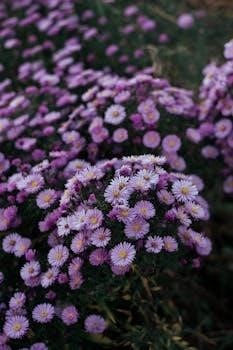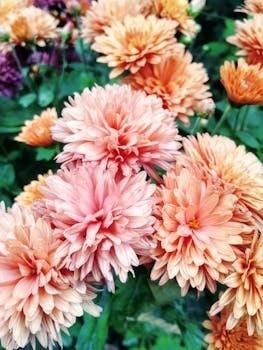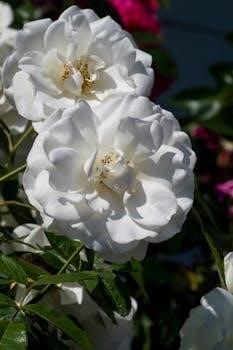Overview of ‘The Chrysanthemums’
John Steinbeck’s “The Chrysanthemums‚” a renowned short story‚ presents a seemingly simple plot that delves into complex themes of gender roles and limitations. Elisa‚ the protagonist‚ finds solace in her garden‚ a space reflecting her inner self.
Published in 1937‚ “The Chrysanthemums” is considered one of John Steinbeck’s most accomplished short stories‚ often studied for its nuanced portrayal of a woman’s inner life. The narrative unfolds in a rural setting‚ centering on Elisa Allen‚ a woman who finds fulfillment in cultivating her chrysanthemums. The story introduces us to Elisa’s world‚ where the boundaries of her existence as a wife and gardener begin to feel limiting. The arrival of a traveling tinker disrupts her routine‚ offering a fleeting glimpse of a different kind of life‚ yet ultimately revealing the stark reality of her situation and the societal constraints she faces‚ setting the stage for deeper exploration of themes such as gender roles.
Elisa’s Character
Elisa Allen‚ the protagonist‚ is a complex figure‚ presented with both strength and vulnerability. She is a capable gardener‚ but also yearns for something more than her current life offers.
Elisa’s Strength and Disillusionment
Elisa is portrayed as a woman of considerable physical strength‚ evident in her assertive handling of garden tools and her vigorous pruning of the chrysanthemums. This strength‚ however‚ masks a deep sense of disillusionment with her life. She is confined to domestic tasks and her role as a wife‚ leaving her unfulfilled. Despite her capabilities‚ she lacks the opportunity to exercise her full potential‚ leading to a subtle yet palpable frustration. Her meticulous care for her chrysanthemums underscores her need for creative and meaningful expression‚ something her marriage and surroundings fail to provide‚ highlighting the contrast between her inner capabilities and her limited outer world.
Elisa’s Longing for Agency
Elisa’s desire for agency is a central aspect of her character. Trapped within the confines of her domestic life‚ she yearns for a more significant role. Her husband’s business dealings take place outside her sphere of influence‚ highlighting her lack of control over her own life. Elisa’s longing manifests in her intense passion for her chrysanthemums‚ where she finds a sense of purpose and power. Her interactions with the tinker reveal her suppressed desire for connection and adventure‚ underscoring her yearning to break free from the limitations imposed on her. This longing for agency is a powerful force driving her actions and emotions throughout the story.

Symbolism of Chrysanthemums
The chrysanthemums in Steinbeck’s story are rich with symbolism‚ representing Elisa’s inner self‚ her repressed energy‚ and her longing for children. They mirror her own beauty and strength.
Chrysanthemums as Symbols of Elisa’s Inner Self
The chrysanthemums are a direct reflection of Elisa’s inner world; like the flowers‚ she is beautiful‚ strong‚ and thriving‚ yet her life is confined within the boundaries of her home and garden. The meticulous care she gives to her flowers mirrors the care she would extend to her own children‚ highlighting her nurturing nature. The chrysanthemums‚ like Elisa‚ are carefully cultivated and orderly‚ mirroring the structured nature of her life. She identifies deeply with them‚ even stating that she feels she becomes the flowers. This connection shows her longing for expression and a life beyond her current circumstances.
Chrysanthemums as Symbols of Elisa’s Repressed Energy
The chrysanthemums serve as potent symbols of Elisa’s pent-up energy and suppressed emotions. They represent her unfulfilled desires and the limitations placed upon her as a woman in a patriarchal society. Her fervent attention to the flowers‚ the aggressive way she cuts the old stalks‚ reveals her inner strength and the frustration she feels within her confined existence. The vibrant and robust nature of the chrysanthemums contrasts with her monotonous life‚ highlighting her repressed vitality. Through the flowers‚ Elisa channels her energy and creativity‚ as they stand for the potential she cannot fully realize.
Chrysanthemums as Symbols of Children
The chrysanthemums also function as symbols of the children Elisa does not have. She nurtures and tends to them with the same care and love that a mother would give to her children. Elisa’s protectiveness over her flowers mirrors a maternal instinct‚ highlighting her longing for motherhood and the fulfillment it could bring. She dedicates her time and energy to their growth‚ suggesting a desire to nurture and raise something precious. The flowers become the recipients of her unspent maternal affection. Her devotion to her garden underscores her unfulfilled role as a mother in a society that values such a role for women.
Themes in the Story
The story explores gender roles and the oppression of women within a patriarchal society. Isolation and limitations are also key themes‚ highlighting Elisa’s yearning for agency and fulfillment.
Gender Roles and Oppression of Women
In “The Chrysanthemums‚” Steinbeck vividly portrays the limitations imposed on women in a patriarchal society. Elisa‚ confined to her roles as wife‚ gardener‚ and housekeeper‚ yearns for a life beyond these prescribed boundaries. She observes her husband engaged in business deals‚ a world from which she is excluded. Her requests‚ like asking for wine at dinner‚ highlight her dependence and lack of agency. The story underscores how women’s potential and desires were often repressed‚ forcing them to seek fulfillment within narrow confines; This creates a sense of confinement and frustration that is central to Elisa’s character and the story’s emotional impact.
Isolation and Limitations
Elisa’s isolation is a prominent theme in Steinbeck’s “The Chrysanthemums‚” highlighting the restrictions placed upon her. Trapped in her domestic routine‚ she experiences a profound sense of disconnect from the world beyond her farm. Her passion for gardening‚ while fulfilling‚ also underscores her limited sphere of influence. The story emphasizes her inability to participate in the public world of business and trade‚ which her husband freely navigates. This exclusion contributes to her feelings of loneliness and frustration. Elisa’s existence is marked by a lack of meaningful connection and freedom‚ reinforcing the limitations imposed upon her by societal norms.

The Encounter with the Tinker
The arrival of the tinker disrupts Elisa’s routine‚ offering a brief connection. His deceptive nature contrasts sharply with Elisa’s authenticity and genuine passion for her flowers.
The Tinker’s Deception and Elisa’s Authenticity
The tinker‚ a traveling repairman‚ initially charms Elisa with his apparent interest in her chrysanthemums. He uses flattery and feigned understanding to obtain what he wants‚ which are the flower cuttings and a few coins. This contrasts starkly with Elisa’s genuine passion for her garden. Her care for the chrysanthemums is a true reflection of her inner self. The tinker’s deception highlights the superficiality of his interaction‚ as he later discards the cuttings‚ revealing his lack of appreciation for Elisa’s efforts and her emotional vulnerability. This encounter underscores the difference between a genuine connection and manipulative behavior.

Steinbeck’s Writing Style
Steinbeck employs evocative language and keen insight to depict Elisa’s emotional state and the story’s themes. His descriptive prose creates a vivid and impactful narrative.
Steinbeck’s Evocative Language and Insight
John Steinbeck’s writing in “The Chrysanthemums” is characterized by its evocative language‚ bringing the setting and characters to life with vivid detail. His insightful portrayal of Elisa’s inner turmoil and her yearning for something more is masterfully done. Steinbeck’s descriptive style captures the beauty of the chrysanthemums and the starkness of Elisa’s environment‚ revealing her emotional landscape. The author’s ability to use simple yet powerful words allows readers to understand the depth of Elisa’s feelings and the oppressive nature of her circumstances. His language creates a powerful resonance with readers‚ highlighting the isolation and limitations faced by women in a patriarchal society‚ making the story both compelling and thought-provoking‚ and leaving a lasting impact.

Background and Context
John Steinbeck‚ often called “the conscience of America‚” wrote “The Chrysanthemums” in 1937; His works frequently explore themes of social injustice and the human condition‚ reflecting his experiences and observations.
John Steinbeck’s Life and Works
John Steinbeck‚ born in 1902‚ was a prolific American author known for his powerful and evocative writing style. He won the Pulitzer Prize in 1940 for “The Grapes of Wrath‚” a novel depicting the struggles of migrant workers during the Great Depression. Steinbeck was awarded the Nobel Prize for Literature in 1962 and the United States Medal of Freedom in 1964‚ solidifying his place as a literary giant. His works explored themes of social injustice‚ the human condition‚ and the struggles of the working class‚ often drawing from his own experiences and observations. Steinbeck’s ability to capture the essence of human emotions and experiences made his stories resonate with readers worldwide. He remains an influential figure in American literature.















